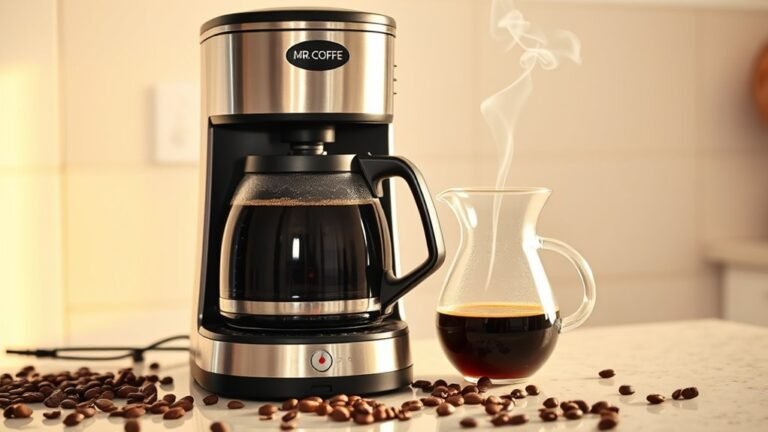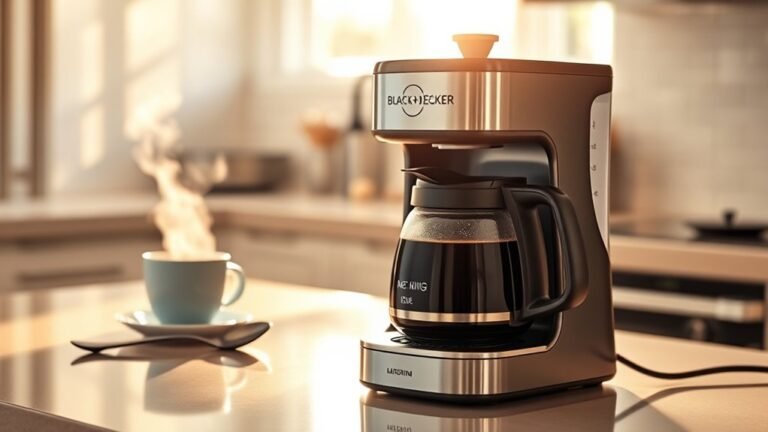The Different Types of Espresso Machines Explained
You’ll find espresso machines ranging from manual to super-automatic, each offering varying degrees of control and convenience. Manual and semi-automatic models let you manipulate grind size, pressure, and timing for precision shots. Automatic and super-automatic machines automate many steps, ensuring consistent quality with minimal input. Capsule machines prioritize speed and simplicity, while stovetop pots offer a straightforward, electricity-free option. Commercial machines feature multi-boilers and programmable dosing for high-volume, consistent results. Exploring these types reveals how each caters to different brewing needs.
Manual Espresso Machines

Although manual espresso machines demand more skill and attention than their automatic counterparts, they offer unparalleled control over extraction variables such as pressure and timing. When you operate one, you directly manage the brewing techniques, adjusting lever pressure and shot duration to tailor flavor profiles precisely. This hands-on approach demands a deep understanding of grind size, tamping force, and water temperature. Your espresso rituals become a disciplined practice, allowing you to explore nuanced variations in crema, body, and acidity. By mastering these variables, you gain the freedom to craft a personalized espresso experience that fully expresses the coffee’s origin and roast characteristics. Manual machines empower you to engage fully with each shot, making the brewing process as rewarding as the final cup.
Semi-Automatic Espresso Machines
With a semi-automatic espresso machine, you control key variables like extraction time and volume, allowing precision during the brewing process. You’ll engage the pump manually to start and stop, which requires careful timing to achieve ideal espresso quality. Regular maintenance and thorough cleaning are essential to preserve the machine’s performance and guarantee consistent results.
Manual Control Features
Because semi-automatic espresso machines give you direct control over the extraction process, you can adjust variables like shot timing and pressure to suit your preferences. This manual control advantage lets you tailor each shot with precision, enhancing flavor complexity and balance. You’ll engage in manual brewing techniques that demand attentiveness and skill, such as starting and stopping the pump exactly when needed. These machines empower you to experiment with parameters, gaining a deeper understanding of espresso dynamics. Unlike fully automatic models, semi-automatics don’t automate your shot; instead, they provide you the tools to master extraction nuances. If you value freedom in crafting espresso and want to refine your technique, these manual control features offer unmatched flexibility and hands-on involvement in your coffee ritual.
Brewing Process Overview
When you’re operating a semi-automatic espresso machine, the brewing process requires your active involvement at every stage to secure ideal extraction. You control the grind size, tamping pressure, and timing, enabling precise manipulation of espresso extraction. Mastery over these brewing techniques lets you tailor the shot’s strength, flavor, and crema quality.
| Step | Your Role | Impact on Espresso Extraction |
|---|---|---|
| Grinding | Adjust grind size manually | Controls flow rate and extraction |
| Tamping | Apply consistent pressure | Guarantees uniform water resistance |
| Brewing | Start/stop water flow | Determines shot volume and timing |
| Monitoring | Observe shot color & texture | Guides adjustments in technique |
This hands-on approach grants freedom to experiment and perfect every espresso shot’s profile.
Maintenance and Cleaning
Although semi-automatic espresso machines give you control over brewing, maintaining their internal components is essential to guarantee consistent performance and longevity. Proper maintenance and cleaning techniques prevent scale buildup and preserve the machine’s precision. Follow these essential maintenance tips:
- Daily Cleaning: Backflush the group head with water and a specialized detergent to remove coffee oils and residues that impact flavor and machine function.
- Weekly Descaling: Use a descaling solution to dissolve mineral deposits inside the boiler and water lines, ensuring ideal pressure and temperature stability.
- Regular Component Inspection: Check and replace worn gaskets and seals to maintain airtight pressure and prevent leaks.
Adhering to these practices keeps your machine operating freely and efficiently, empowering you to craft perfect espresso shots consistently.
Automatic Espresso Machines
With automatic espresso machines, you’ll benefit from precise control over shot timing and volume, simplifying your extraction process. These machines handle most brewing steps with minimal input, yet require regular maintenance to guarantee consistent performance. Understanding their operation and upkeep is essential for maintaining peak espresso quality.
Features and Benefits
An automatic espresso machine offers a streamlined brewing process by integrating programmable settings that control grind size, tamping pressure, water temperature, and extraction time. These espresso features deliver consistent quality and allow you to customize every shot with precision. The espresso benefits are clear: you gain freedom from manual adjustments while maintaining control over flavor nuances. Here’s what you can expect:
- Precise consistency — exact parameters guarantee uniform taste cup after cup.
- Time efficiency — automated cycles speed up your routine without sacrificing quality.
- Customization flexibility — save multiple user profiles to suit different preferences effortlessly.
Operation and Maintenance
Because automatic espresso machines combine complex mechanical and electronic components, understanding their operation and maintenance is essential to assure peak performance and longevity. You’ll need to regularly clean the group head, descale the machine, and inspect electronic sensors to ensure consistent espresso extraction quality. Neglecting these tasks compromises machine longevity and brew consistency.
| Task | Frequency | Purpose |
|---|---|---|
| Group Head Cleaning | Daily | Prevents coffee residue buildup |
| Descaling | Monthly | Removes mineral deposits |
| Sensor Inspection | Quarterly | Ensures accurate operation |
| Software Updates | As released | Optimizes performance and fixes |
Maintaining this routine grants you freedom from breakdowns and supports flawless espresso extraction every time.
Super-Automatic Espresso Machines
Super-automatic espresso machines deliver a fully integrated brewing process by automating grinding, tamping, brewing, and milk frothing with minimal user input. If you’re seeking a seamless user experience paired with robust machine durability, these machines are designed for you. They free you from manual adjustments while maintaining consistent coffee quality. Here’s what sets them apart:
Effortless brewing with integrated grinding, tamping, and frothing for consistent, high-quality espresso every time.
- Complete Automation: From bean to cup, every step is precisely controlled to guarantee excellent extraction without effort.
- Built-in Grinder and Frother: Integrated components reduce the need for additional equipment, enhancing convenience and speed.
- Durability and Maintenance: Engineered with high-grade materials, they withstand frequent use and simplify cleaning to extend lifespan.
Choosing a super-automatic machine means embracing freedom without compromising technical excellence or reliability.
Capsule or Pod Espresso Machines

While super-automatic machines offer unparalleled convenience through full automation, capsule or pod espresso machines take simplicity to another level by using pre-measured coffee doses enclosed in sealed pods. These machines rely on precise pressure and temperature controls to extract espresso uniformly from coffee pods, minimizing user intervention. You simply insert a pod, initiate the brew cycle, and the machine handles tamping, dosing, and extraction. This design greatly enhances the convenience factor, eliminating the mess and variability of ground coffee. Although capsule systems limit your freedom to customize grind size or tamp pressure, they grant unparalleled consistency and speed, making them ideal for users prioritizing efficiency without sacrificing quality. The sealed coffee pods also preserve freshness longer, ensuring a reliable, fresh shot every time with minimal cleanup.
Stovetop Espresso Makers
A stovetop espresso maker, often called a Moka pot, brews espresso by forcing boiling water pressurized by steam through finely ground coffee. This method of stovetop brewing offers you an independent way to make rich espresso without electricity or complex machinery. Here’s what you need to know:
- Design: The moka pot consists of three chambers—water reservoir, coffee basket, and collection chamber—ensuring precise pressure and extraction.
- Operation: As water boils, steam pressure pushes hot water up through the coffee grounds, extracting bold flavors.
- Control: You control grind size, heat, and coffee dose, giving you freedom to tweak taste and strength.
Using a moka pot, you embrace a simple, reliable espresso-making technique that’s perfect for anyone seeking autonomy in their coffee ritual.
Commercial Espresso Machines
Commercial espresso machines come in a variety of configurations designed to handle high volumes and deliver consistent shot quality under demanding conditions. If you need reliable machine efficiency for a busy café or restaurant, these machines offer programmable dosing, multi-boiler systems, and powerful pumps. You’ll appreciate how their build quality and automation save you time and reduce errors, freeing you to focus on crafting excellent coffee.
| Feature | Benefit | Impact on Use |
|---|---|---|
| Multi-boiler | Independent temperature control | Precise extraction |
| Programmable dosing | Consistent shot volume | Uniform taste |
| High-pressure pump | Stable pressure | Enhanced crema quality |
| Durable materials | Long lifespan | Reduced maintenance |
Choosing the right commercial espresso machine means balancing efficiency and volume without sacrificing quality.
Frequently Asked Questions
How Does Water Temperature Affect Espresso Flavor?
Water temperature critically influences water extraction during espresso brewing, directly shaping your espresso’s flavor profile. If the temperature’s too low, extraction is underdone, resulting in sour, weak flavors. Too high, and you risk over-extraction, making your espresso bitter or burnt. Ideally, you want a precise temperature range, usually around 90-96°C, to balance acidity, sweetness, and bitterness, giving you full control over your espresso’s complexity and richness.
What Type of Coffee Grind Is Best for Espresso?
Think of your coffee grind as the sails catching the wind—too coarse, and you lose power; too fine, and you risk stalling. For espresso extraction, a fine grind is essential because it allows water to evenly saturate the coffee grounds under pressure, revealing rich flavors and crema. You’ll want to dial in the grind size precisely to balance flow rate and extraction time, ensuring your espresso is bold, balanced, and vibrant every shot.
Can I Use Regular Coffee Beans for Espresso?
You can use regular coffee beans for espresso, but it’s best to choose espresso bean types specifically roasted for intense, concentrated brewing techniques. Regular beans, often lighter roasted, might not extract properly under high pressure, resulting in a weaker shot. For ideal crema and flavor balance, select beans designed for espresso’s fine grind and fast extraction. This way, you maintain freedom in your coffee choice without sacrificing technical quality and taste precision.
How Often Should I Clean My Espresso Machine?
You should stick to a regular cleaning frequency to keep your espresso machine performing at its best. Daily, rinse the portafilter and group head to avoid coffee residue buildup. Weekly, run a backflush with a cleaning detergent to maintain internal cleanliness. Monthly, descale to prevent mineral deposits. Maintenance tips like these guarantee your machine stays reliable, giving you the freedom to enjoy perfect espresso shots without interruptions or flavor issues.
What Is the Ideal Pressure for Pulling Espresso Shots?
Think of pressure consistency as the heartbeat of your espresso shot—it keeps extraction alive and vibrant. Ideally, you want about 9 bars of pressure for peak espresso extraction. This guarantees water flows through the coffee grounds evenly, revealing rich flavors and balanced crema. If pressure wavers, your shot suffers. So, maintaining steady pressure isn’t just technical—it’s your gateway to free, flavorful espresso adventures every time you pull a shot.






